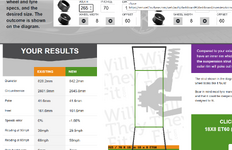When I was the owner of a 2012 Subaru Outback 3.6R Limited, I learned that if you had a tire that suffered catastrophic damage, requiring replacement, that you had to replace all four of the tires, if they had more than 10,000 miles on them. This was because the new tire would spin at a ‘different speed’ than the other three warn (smaller diameter) tires, if for instance the set of tires had 20,000 to 30,000 miles on them. Since the new LC is a true AWD vehicle, is that also the case for this drivetrain?
Navigation
Install the app
How to install the app on iOS
Follow along with the video below to see how to install our site as a web app on your home screen.
Note: This feature may not be available in some browsers.
More options
You are using an out of date browser. It may not display this or other websites correctly.
You should upgrade or use an alternative browser.
You should upgrade or use an alternative browser.
Tire replacement after a severely damaged tire.
- Thread starter ultane
- Start date
Yeah, at least according to Toyota techs, you don't really want to run one tire that's way off. Two things you can do about it: (1) rotate all 5 tires so none of them are way out, if the worse happens you can make the replacement your spare. (2) Put better than stock tires on it. On three Toyota trucks now, mostly running either the original BFG A/T KO's or Duratracs, I've never had tire damage that couldn't be repaired. If you rock crawl around sharp rocks (I try not to) YMMV.
Some tire shops even have a machine that will shave down the new tire to match the existing 3 tires.
I wouldn’t be concerned if the other tires had 10-20k miles. 30k+ and you’re probably looking to replace all tires anyway. If the size is within a half inch don’t worry about it and you’ll only need to use the locking center and rear differential when you lose significant traction and in that case you’ll experience tire slipping anyway.
Every time you turn a corner the inside tires do not roll as far or as fast as the outside tires. This is due to the differentials being designed to allow for that very thing.
That being said, it's always been my habit to have matched tires on the front. If one blew out and I had to buy a new one, I'd put the new one and the spare on the front and place the one good one that came off as the spare.
If I had another blow out, I would decide: If the spare matched the existing front and place the new one as a spare, or if I need two new tires for the front or replace all 4. It would greatly depend on even wear and if any of the existing tires had cupping etc.......
That being said, it's always been my habit to have matched tires on the front. If one blew out and I had to buy a new one, I'd put the new one and the spare on the front and place the one good one that came off as the spare.
If I had another blow out, I would decide: If the spare matched the existing front and place the new one as a spare, or if I need two new tires for the front or replace all 4. It would greatly depend on even wear and if any of the existing tires had cupping etc.......
If you have the means to purchase a new tire(s) if needed, I'd leave the stock spare. In your example you are going with stock diameter but a wider tire. It would drive almost the same other than it might drag on the wider side and that could be eliminated by putting two 275's on the front if you had a flat in the front. If you had a flat in the rear, you wouldn't be able to tell the difference.Good question if your going up in size on stock tires. For example I am going to 275/70/18 and the stock is 265/70/18. Should I leave the spare the original stock size or buy 5 tires?
Not to be anal but a 275/70/18 will theoretically be a larger diameter than a 265/70/18 since the 70 designates the sidewall height to be 70% of the tires width,(265 or 275). Or at least that’s how I understand tire sizes.
Tires are pricey, I would also keep the stock spare and if I got a flat try to get it fixed asap.
True according to tire size calculator online the 275 size is 33.2" diameter vs the 265 which is 32.6" diameter.Not to be anal but a 275/70/18 will theoretically be a larger diameter than a 265/70/18 since the 70 designates the sidewall height to be 70% of the tires width,(265 or 275). Or at least that’s how I understand tire sizes.
True, although the diameter is not designated as 275 or 265. The # after this will designate the diameter. A 265/75/18 will most likely have a larger diameter than a 275/65/18. First # is width in mm’s. Next is aspect ratio in % meaning the distance from rim or inside tire to the outside of the tire. 75% of 265mm or 65% of 275 mm’s. The third and final # is the diameter of the rim in inches. It can be confusing because both the metric and standard units of measurement are in the tire size.True according to tire size calculator online the 275 size is 33.2" diameter vs the 265 which is 32.6" diameter.
Similar threads
- Replies
- 0
- Views
- 615
- Replies
- 1
- Views
- 1K
- Replies
- 15
- Views
- 1K


